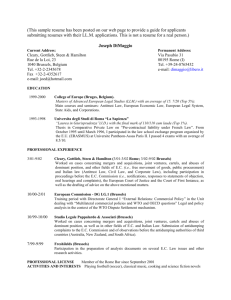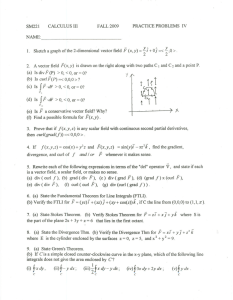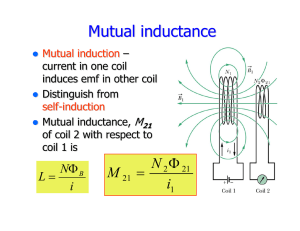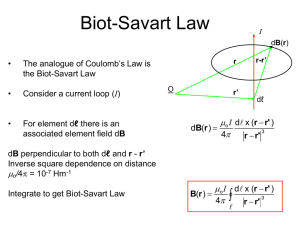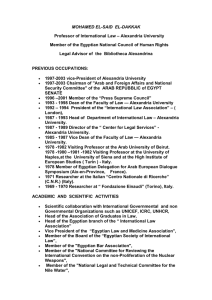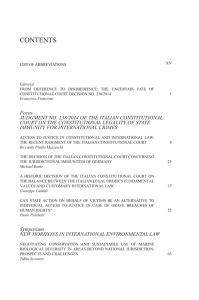Massachusetts Institute of technology Department of Physics 8.022 Fall 2004/11/09
advertisement
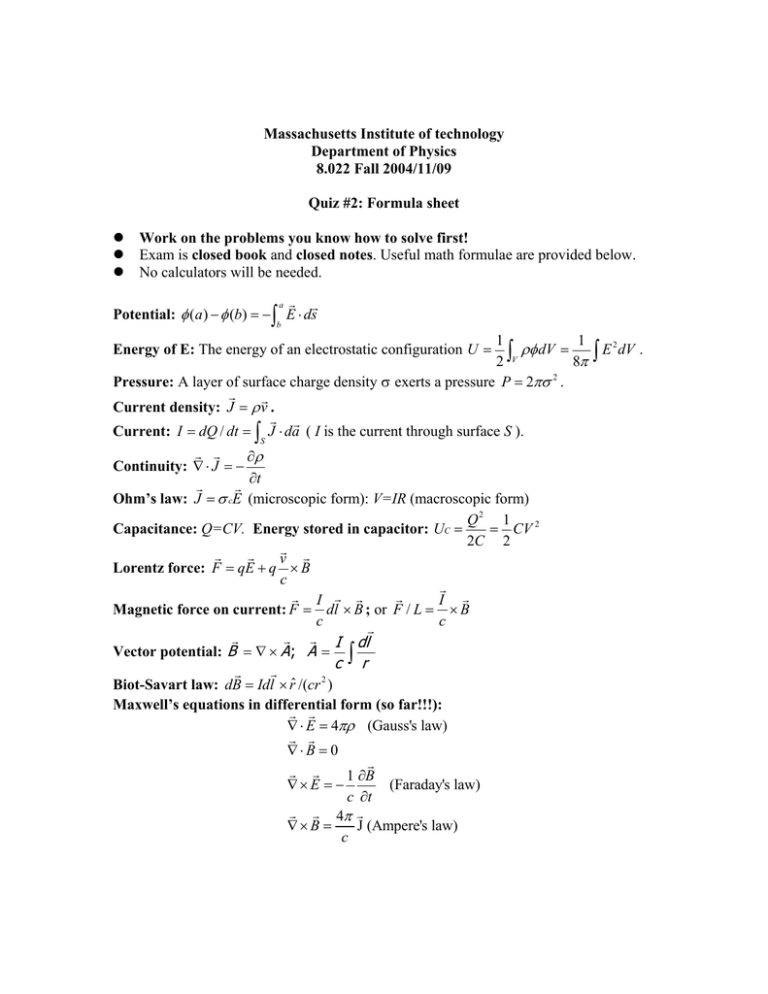
Massachusetts Institute of technology Department of Physics 8.022 Fall 2004/11/09 Quiz #2: Formula sheet Work on the problems you know how to solve first! Exam is closed book and closed notes. Useful math formulae are provided below. No calculators will be needed. a Potential: φ (a ) − φ (b) = − ∫ E ⋅ ds b 1 1 ρφ dV = E 2 dV . ∫ 2 V 8π ∫ Pressure: A layer of surface charge density σ exerts a pressure P = 2πσ 2 . Energy of E: The energy of an electrostatic configuration U = Current density: J = ρ v . Current: I = dQ / dt = ∫ J ⋅ da ( I is the current through surface S ). S ∂ρ ∂t Ohm’s law: J = σ cE (microscopic form): V=IR (macroscopic form) Q2 1 Capacitance: Q=CV. Energy stored in capacitor: UC = = CV 2 2C 2 v Lorentz force: F = qE + q × B c I I Magnetic force on current: F = dl × B ; or F / L = × B c c Continuity: ∇ ⋅ J = − Vector potential: B = ∇ × A ; A = I c ∫ dl r Biot-Savart law: dB = Idl × r̂ /(cr 2 ) Maxwell’s equations in differential form (so far!!!): ∇ ⋅ E = 4πρ (Gauss's law) ∇⋅B = 0 ∇× E = − ∇× B = 1 ∂B (Faraday's law) c ∂t 4π J (Ampere's law) c Maxwell’s equations in integral form (so far): ∫ E ⋅ da = 4π Q (Gauss's law. Q is charge enclosed by surface S) S ∫ C E ⋅ ds = − 1 ∂φ B =e.m.f. (Faraday's law. φ B is B flux through surface bounded by C.) c ∂t 4π I (Ampere's law. I is current enclosed by contour C.) C c Self inductance: ε = −LdI / dt Mutual Inductance: ε 1 = −M 12 dI 2 / dt ; ε 2 = −M 21dI 1 / dt ; M 12 = M 21 1 B 2 dV Magnetic energy: U = 8π ∫ 1 Energy stored in an inductor: UL = LI 2 2 ∫ B ⋅ ds = Time dilation: Moving clocks run slow: ∆tstationary = γ∆tmoving Length contraction: Moving rulers are shortened: Lstationary = Lmoving / γ Transformation of fields: denotes parallel to v , ⊥ denotes perpendicular to v v E' = E E⊥' = γ (E⊥ + × B⊥ ) c v B' = B B⊥' = γ (B⊥ − × E⊥ ) c Useful Math Cartesian. ∂t ∂t ∂t x̂ + ŷ + ẑ ∂x ∂y ∂z ∂ v ∂ v y ∂ vz Divergence: ∇ ⋅ v = x + + ∂x ∂y ∂z ∂ v y ∂ vx ∂v ∂v ∂ v ∂ vy ) x̂ + ( x − z ) ŷ + ( − )ẑ Curl: ∇ × v = ( z − ∂y ∂z ∂z ∂x ∂x ∂y Gradient: ∇t = Laplacian: ∇ 2 t = ∂ 2t ∂ 2t ∂ 2 t + + ∂ x2 ∂ y2 ∂ z2 Spherical. ∂t 1 ∂t 1 ∂t r̂ + θ̂ + φ̂ ∂r r ∂θ r sin θ ∂ φ ∂ 1 ∂ 1 1 ∂ vφ ( r 2 v r )+ Divergence: ∇ ⋅ v = 2 (sin θvθ )+ r sin θ ∂ θ r sin θ ∂ φ r ∂r Gradient: ∇t = Curl: ∇×v = ∂ (sin θvφ ) ∂ vθ 1 1 1 ∂ v r ∂ (rvφ ) 1 ∂ (rvθ ) ∂ v r − − − ]θ̂ + [ ]φ̂ [ ]r̂ + [ ∂θ ∂φ ∂r ∂θ r ∂r r sin θ r sin θ ∂ φ ∂t ∂ 2t 1 ∂ 2 ∂t 1 1 ∂ (r )+ (sin θ )+ Laplacian: ∇ t = 2 ∂ r r 2 sin θ ∂θ ∂ θ r 2 sin 2 θ ∂ φ 2 r ∂r 2 Cylindrical. ∂t ∂t 1 ∂t ρ̂ + φ̂ + ẑ ∂ρ ρ ∂φ ∂z 1 ∂ 1 ∂ vφ ∂ v z Divergence: ∇ ⋅ v = ( ρv ρ ) + + ρ ∂ρ ρ ∂φ ∂z ∂v ∂v 1 ∂ vz ∂ vφ 1 ∂ ( ρ vφ ) ∂ vρ Curl: ∇ × v = [ − − ]ρ̂ + [ ρ − z ]φ̂ + [ ]ẑ ρ ∂φ ∂ z ∂z ∂ρ ρ ∂ρ ∂θ ∂t 1 ∂ 2t ∂ 2 t 1 ∂ Laplacian: ∇ 2 t = (ρ )+ 2 + ρ ∂ρ ∂ ρ ρ ∂φ 2 ∂ z 2 Gradient: ∇t = Binomial expansion: (1 ± x )n = 1 ± nx 1! Stokes’ theorem: Gauss’ theorem: + n (n − 1)x 2 2! ± (x 2 < 1);(1 ± x ) −n = 1 ∓ ∫ F ⋅ ds = ∫ curl F ⋅ dA ∫ F ⋅ dA = ∫ div FdV C S S V nx 1! + n (n + 1)x 2 2! ∓ (x 2 < 1)


